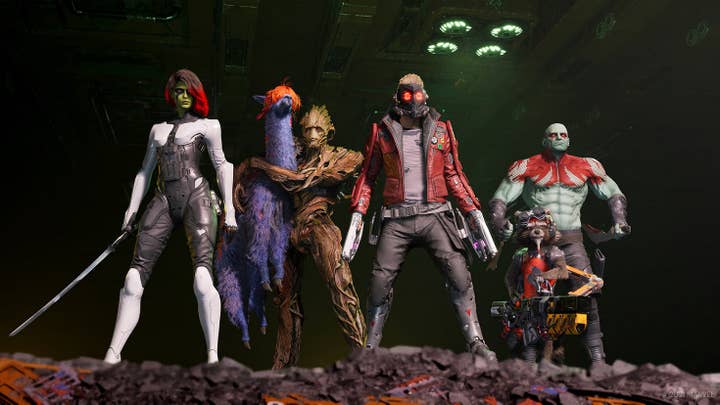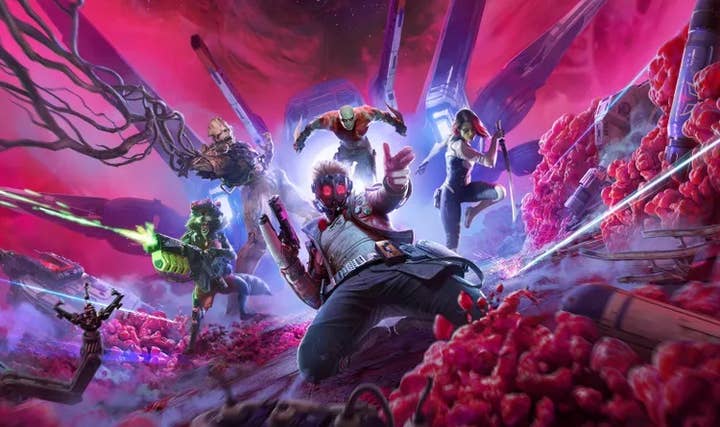Guardians of the Galaxy's guiding design decisions
Eidos Montreal narrative and gameplay leads explain why the Marvel super hero team's game will lock players in one character's jet boots
Mary DeMarle and Patrick Fortier are used to collaborating.
The Eidos Montreal developers first worked together on 2004's Myst 4: Revelation, and have worked on a handful of projects together since then, with DeMarle in a narrative position and Fortier in a gameplay role.
They find themselves collaborating once again on Marvel's Guardians of the Galaxy, with DeMarle working as senior narrative director and Fortier as senior gameplay director. And while the pair are well acquainted with the idea that what a game needs from a story perspective and what it needs from a gameplay perspective are sometimes at odds, they tell GamesIndustry.biz that something has been different this time around.
"I think this project probably pushed us to work even more together than perhaps past projects," Fortier says.
For Guardians of the Galaxy, Fortier says the narrative has been an integral part of the game in a way it wasn't for previous titles they had both worked on. And even though he sees the needs of the game's narrative shaping gameplay aspects more than on other projects, he doesn't characterize it as an antagonistic relationship.

"You have to understand what kind of game you're making," Fortier says. "It was clear from the start we were making a narrative-driven action-adventure game. It's the narrative that's going to bring these characters to life, that's going to make the experience unique, that's going to make the game memorable. So we need to pave the way for it. We need to make concessions to pure gameplay, if need be, because it's important to not break the illusion that these characters are alive, that they're true to their personality and... they're part of the team with you."
DeMarle agrees, particularly about the important of understanding what the game is meant to be.
"It's the narrative that's going to bring these characters to life. So we need to pave the way for it. We need to make concessions to pure gameplay, if need be"Patrick Fortier
"For many, many years working in this industry, I've known that story is often subservient to gameplay," DeMarle says. "But if I understand the game and what is the feeling I'm trying to evoke for players, then I can understand that gameplay is trying to do it this way, and story is here to support that or bring it forward. How can the things I write help to emphasize the things the gameplay needs, etc.?
"As long as you always know the game you're trying to make and understand why, then it just comes down to constant communication between narrative and gameplay, and constantly looking and understanding it from that point of view."
The core idea of the Guardians of the Galaxy game came from Marvel, in the sense that the comic company gave them one clear edict from which the creative decisions sprang.
As DeMarle recalls, "They basically told us: 'We want you to create a game that is the Eidos Montreal version of Guardians of the Galaxy. We don't want you to make the movie version, we don't want you to make the comic books. We want you to make this your own, as long as you stay true to the essence of who these characters are'."
Given that the Guardians of the Galaxy are a team, the studio gave some thought to co-op and multiplayer treatments, even though it has a reputation for single-player-focused games like Deus Ex: Mankind Divided and Shadow of the Tomb Raider. However, the goal of staying true to the characters led them in another direction.
"We weren't pressured to look into trends. We just looked at the source material, and it became pretty clear that we were going to hit the core of the Guardians through the narrative"
Patrick Fortier
"Pretty quickly we stumbled on the idea that what really makes the Guardians unique are the characters themselves, how zany and unpredictable they are, the dysfunction that exists within them," DeMarle says. "So we started thinking about what it would be like to actually be in the center of all that, so you're hanging out with those characters and experiencing them in their full glory."
It's a markedly different approach from that of Square Enix's other big AAA Marvel game, the online co-op live service title The Avengers.
"It's a combination of our history, our likes, and our blessings," Fortier says of the decision to go single-player for Guardians. "We weren't pressured to look into trends. We just looked at the source material, and it became pretty clear that we were going to hit the core of the Guardians through the narrative. And if you're going to do narrative, then it's not necessarily super-conducive to [live service or multiplayer games]."
The team opted to not only go single-player, but to limit the player's direct control to that of Peter Quill (aka Star-Lord), the supposed leader of the group who seems to embody none of the traditional traits associated with leadership.

While players can still call on the other Guardians for help while moving around the levels or in combat, they are forced to manage the team's unpredictability from the same perspective as Quill. Depending on circumstances, the team won't always be eager to follow Quill's commands, so players will have to consider group dynamics in dealing with them just as Quill would.
"You feel it more as a way of communicating with the Guardians after a while than just a pure mechanical function on a controller," Fortier says.
And while he concedes it's not a perfect analogy, Fortier says he took some inspiration from various team sports titles that have modes that lock a player into one specific position. He says it changes the experiences when they must fill a defined role rather than control whoever's in the spotlight at a given moment.
"By going single-player, we're able to focus on building a strong story... We can put ourselves in a single viewpoint that is facing the story"
Mary DeMarle
DeMarle adds: "By going single-player, we're able to focus on building a strong story... We can put ourselves in a single viewpoint that is facing the story. And knowing that you're working with a team of characters who are unique individuals and very unpredictable, it allows us to start playing with that to build a stronger narrative."
It helps that Eidos Montreal found a narrative theme in leadership that also has gameplay applications that can push in the same direction.
"I've always said the thing to understand is the theme," DeMarle says. "That's one of the deciding things that can help to merge story and gameplay together. For this game, yes, the fact this is a team that's trying to come together as a family, as a team, and trying to put their past behind them and Peter is a new, young leader, that gives us one of the themes of the game. "
Fortier adds, "That's why we wanted to have the conversation system. The social filler is very important to our game. Yes, we have traversal mechanics and combat mechanics, but the social mechanics are part of both."
The social mechanics cover a few different situations. As the team makes its way through the world, they will talk, and at various points in the conversation Quill will be given the chance to respond, steering a conversation in one direction or another, or perhaps just staying silent.
There will also be a "huddle up" mechanics where Quill can push the right buttons (so to speak) in a pep talk to motivate the team, and "battle of wits" segments where he must manipulate the person he's talking with to achieve a goal.
Fortier notes these social mechanics are influencing even the level design of the game, as locations must be laid out and traversal mechanics paced in such a way as to allow the conversations to play out appropriately
"One of our biggest challenges was making sure the guardians feel alive 100% of the time," DeMarle says. "To hear them banter and see them go through their own journeys, and it's going to be exciting for us to see what people experience and feel in terms of that."

